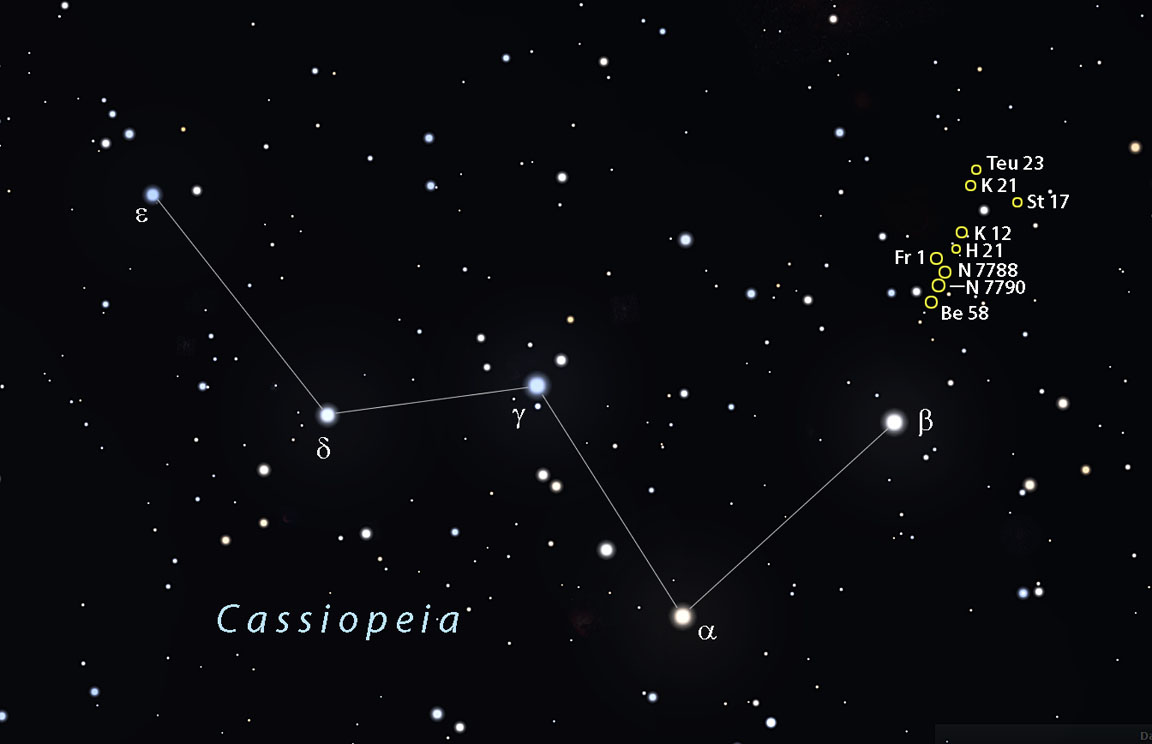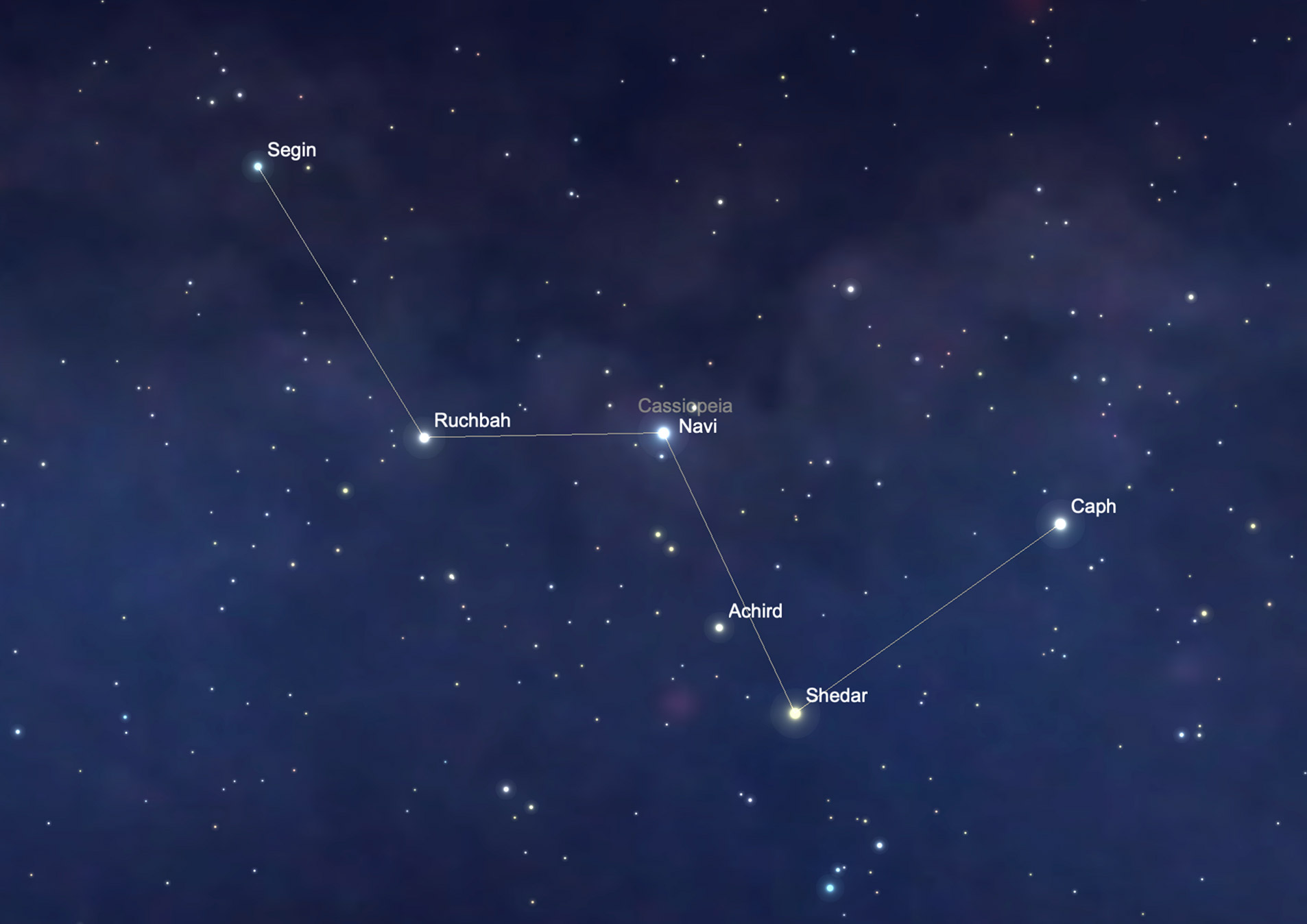Cassiopeia Constellation: Facts, Myth, Location, Stars
- Home
- chevron_right
- Astronomy
- chevron_right
- Cassiopeia Constellation: Facts, Myth, Location, Stars
Cassiopeia is one of the largest constellations in the sky, located on the northern side. It took its name from Cassiopeia, a queen found in Greek mythology. It contains five bright stars and is easily recognizable due to its distinctive ‘W’ shape. It is visible throughout the year from most locations on Earth. In Cassiopeia, there are several deep sky objects of note, including the open clusters Messier 52 and Messier 103, the Heart Nebula and the Soul Nebula, the supernova remnant Cassiopeia A, and the star-forming cloud Pacman Nebula. This constellation belongs to the Perseus family, including Andromeda, Auriga, Cepheus, Cetus, Lacerta, Pegasus, and Perseus. This article will explore the facts, location, and myth surrounding this Cassiopeia constellation.
Facts about Cassiopeia Constellation
The constellation Cassiopeia, pronounced as /ˌkæsioʊˈpiːə/, is also referred to as the Seated Queen in English. When using the genitive form for star names, it is called Cassiopeiae, pronounced /ˌkæsioʊˈpiːiː/. 1922 the International Astronomical Union (IAU) adopted the three-letter abbreviation “Cas” to represent this constellation.
Cassiopeia is a prominent constellation, easily recognizable by its distinctive W or M shape, depending on its orientation in the sky.
Named after the vain queen of Greek mythology, Cassiopeia is home to several notable stars and celestial objects:
- Cassiopeia is one of the 88 modern constellations recognized by the International Astronomical Union (IAU) and is part of the Perseus family of constellations.
- Cassiopeia is home to several deep-sky objects, including the Heart Nebula (IC 1805), the Soul Nebula (IC 1848), and the famous double cluster (NGC 869 and NGC 884).
- The constellation also contains several interesting variable stars, such as Rho Cassiopeiae, a rare yellow hypergiant star, and V509 Cassiopeiae, a luminous blue variable star.
Cassiopeia: Where is it located in the sky?
Looking up in the sky, Cassiopeia can be seen in the first quadrant of the northern hemisphere (NQ1) at a latitude between +90° and -20°. With an area of almost 600 square degrees, it is the 25th largest constellation in the sky. The husband of Cassiopeia, Cepheus, surrounds the Cassiopeia constellation. According to Greek mythology, Andromeda, a daughter of Cassiopeia, is next to it and its husband, Perseus. To locate Cassiopeia, look for the Big Dipper and follow the line created by the two stars at the end of the Dipper’s bowl (Merak and Dubhe) to the bright star Polaris (the North Star). Cassiopeia will be nearby, with its distinctive W or M shape making it easy to spot.
Stars located in the Cassiopeia constellation
Cassiopeia is known for its distinctive W shape made by five bright stars in the constellation. As seen from left to right, Segin (Epsilon Cassiopeiae), Ruchbah (Delta Cassiopeiae), Gamma Cassiopeiae, Schedar (Alpha Cassiopeiae), and Caph (Beta Cassiopeiae).
-
Schedar star (Alpha Cassiopeiae)
Schedar is the brightest star in the constellation Cassiopeia and is one of the four brightest stars in the northern celestial hemisphere. Schedar (sometimes called Shedir) is of spectral type K0IIIa, a 228-light-year distant orange giant. Based on the photometric system, its apparent magnitude can be either brighter or fainter than Caph (Alpha Cassiopeiae). It is in the range of 2.20 to 2.23 magnitudes. On the W asterism, Schedar can be found at the bottom right. Schedar is a traditional name derived from the Arabic word “şadr”, meaning breast because of the star’s position.
-
Caph star (Beta Cassiopeiae)
The Caph star, belonging to the spectral type F2 III-IV, is approximately 54.5 light years away. The star is classified as a Delta Scuti-type variable star. It has an apparent magnitude of 4.84 and is visible to the naked eye under favorable conditions, the 12 largest stars in the sky. This type of star is known for its small, regular fluctuations in brightness as it pulsates, and its magnitude variability is within the average range for Delta Scuti stars. Its brightness and size make it one of the most visible stars in the night sky, and its traditional name is derived from Arabic, indicating its prominence in the culture.
-
Ruchbah star (Delta Cassiopeiae)
The fourth brightest star in the Cassiopeia constellation is Delta Cassiopeia, known as Ruchbah, derived from the Arabic name rukbah, which means “knee”.
Ruchbah is a double-star system composed of two stars orbiting around each other. It is approximately 99 light years away from Earth with an apparent magnitude of delta that ranges between 2.86 and 2.74.
-
Segin star (Epsilon Cassiopeiae)
The sign star is one of the prominent stars in the constellation and has a mass of 6.5 times that of the Sun. Belonging to B star classes, emit a ring followed by a revolving speed.
Segin is about 430 light-years away from the Earth with an apparent magnitude of 3.34.
-
Gamma Cassiopeiae
Gamma Cassiopeiae is placed in the center of a W shape and is currently the brightest star in the constellation. It is a blue star about 610 light years away from Earth, which is 40,000 times brighter than the Sun and has about 15 solar masses.
Gamma stars move so fast that they bulge outward along the equator. A “decretion disk” is shaped around the star due to lost mass and material. Gamma Cassiopeiae is a spectroscopic binary star system featuring an optical double star with a magnitude 11 companion approximately two arcs seconds apart. This companion star has a mass similar to that of our Sun. The system completes an orbit approximately every 204 days.
-
Achird star (Eta Cassiopeiae)
Eta Cassiopeiae, or Achird, is the closest star to our solar system within the Cassiopeia constellation. It is located only 19.4 light years away with an apparent magnitude of 3.45; it is visible to the naked eye. It is a yellow-white G-class hydrogen fusing dwarf, similar to the Sun, but slightly cooler with a surface temperature of 5730 Kelvin.
Achird is a binary star system consisting of a dimmer companion, an orange K-class dwarf with an apparent magnitude of 7.51, located 11 arc seconds away. The two stars are classified as an RS Canum Venaticorum type variable star, forming a close binary star with active chromospheres that cause large stellar spots. These spots cause the star system’s luminosity variations, resulting in a brightness variation of 0.05 magnitudes.
Mythology of Cassiopeia Constellation
The constellation Cassiopeia is steeped in Greek mythology, named after the legendary queen of Ethiopia, Cassiopeia. According to the myth, Cassiopeia was a beautiful but vain queen who boasted that she and her daughter, Andromeda, were more beautiful than the Nereids, sea nymphs, and daughters of the sea god Nereus. This boast angered the sea god Poseidon, who sent a sea monster, Cetus, to ravage the kingdom of Ethiopia. Cassiopeia and her husband, King Cepheus, were advised to sacrifice their daughter Andromeda to the sea monster to appease Poseidon and save their kingdom. Andromeda was chained to a rock by the sea, but she was ultimately saved by the hero Perseus, who slew the monster and married her.
As punishment for her vanity, Poseidon placed Cassiopeia in the sky, where she is forever bound to her celestial throne. The constellation’s distinctive W or M shape is said to represent Cassiopeia’s throne, and the queen can be seen sitting on it, either right-side up or upside down, depending on the time of year.
Wrapping up
Cassiopeia is the largest constellation in the sky that has intrigued stargazers for centuries. Its unique shape, fascinating celestial objects, bright stars, and rich mythology make it a must-see for anyone passionate about astronomy or mythology. In this article, we provide information about the Cassiopeia constellation and hope you find this article helpful in providing details about the Cassiopeia constellation. Are you interested in these subjects? Which constellation grabs your attention more?
Please share your thoughts in the comments section by sharing them with us.
References:
Table of Contents
Recent Posts
- What is Gravity?
- whirlpool galaxy (Messier 51); Facts, Location, Type
- Astronomy; Definition, Types, History and Facts
- Draco Constellation; Facts, Myth, Location, Stars
- Cassiopeia Constellation: Facts, Myth, Location, Stars
- Zodiac Constellations; Facts, Stars, Symbols, Dates, Signs
- Atik Star Omicron Persei; +10 Facts, Myth, Features
- Algol Star β Persei; +10 Facts, Myth, Features
Suggest Posts
- What is Gravity?
- whirlpool galaxy (Messier 51); Facts, Location, Type
- Astronomy; Definition, Types, History and Facts
- Draco Constellation; Facts, Myth, Location, Stars
- Cassiopeia Constellation: Facts, Myth, Location, Stars
- Zodiac Constellations; Facts, Stars, Symbols, Dates, Signs
- Atik Star Omicron Persei; +10 Facts, Myth, Features
- Algol Star β Persei; +10 Facts, Myth, Features
Categories

Nazanin Teymoori
Hi there, I am Nazanin, a member of the Aquilae Constellation team. And also the author of all the texts of this blog.
I am delighted that after many years of great interest in astronomy, I launched this website with the help of our professional team. We have many challenges ahead of us, but we promise ourselves that we will overcome everything.
I love astronomy So Let's go






